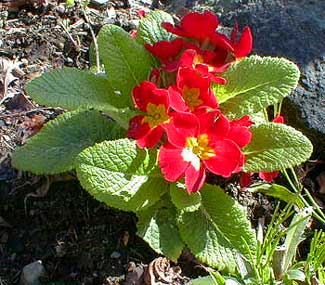
'Red & Gold' Finesse Primrose
"O fairest Flower, no sooner blown but blasted,
Soft silken Primrose fading timelessly,
Summer's chief honour, if thou hadst outlasted
Bleak Winter's force that made thy blossom dry;
For he, being amorous on that lovely dye
That did thy cheek envermeil, thought to kiss
But killed, alas! and then bewailed his fatal bliss."
-John Milton
(1608-1674)
(1608-1674)
Around the winter holidays, scores of "mixed" primulas appear in garden shops, department stores, hardware stores, grocery stores, & drugstores. Some of them are fragile defacto annuals, others are hardy evergreens, & there are no distinguishing labels on them for the novice gardener who is being targetted by this blitz of winter color.
It's probably best to hand-select specific cultivars from a quality nursery, & to look up each species for its care & habits before selecting. Yet when passing these latep-winter racks of extreme colors placed at the doorways of so many types of stores, it can be terribly difficult not to grab one, or several, especially if they're on sale for only 94 cents.
Well, if you spot any labeled "Finesse Mix," those you can sometimes turn out to be garden-hardy perennials bred from Primula vulgaris (acaulis). Despite being so often a greengrocer offering rather than merely from fine nurseries, the Finesse series really is one of the grandest group of hardy evergreen primroses. Finesse primroses bloom winter through early spring with great intensity & lasting power, & their basal leaves are strongly evergreen the rest of the year, needing only occasional under-trimming to get older worn-out leaves out of the way. Their greatest drawback is lack of subtlty, & many a serious gardener prefers subtler varieties & species primroses such as are not mass-produced for the winter glut. But any tendency to elitism regarding such common offerings can be hard to sustain when one ponders the possibility of so much color in the garden even in winter.
Two other series designated "Joker" or "Finale" are also P. vulgaris so you can safely choose them for favorite colors & expect them to do well after you get them home. By contrast, if you're in a temperate or chilly zone, avoid the upright-stemmed "Prima" varieties that are frequently in the same unnamed batches of winter offerings. These are P. malacoides & will never look as nice in the garden as they look fresh from the grower's greenhouse, & will die as defacto annuals, being intolerant of cold.
When the season is wearing down & the remaining primroses go from cheap to fantastically cheap, you can still grab the "Finesse" varieties & expect to have them return the following winter & spring, whereas any worn-out M. malacoides you're hornswoggled into buying will die rather than living to shine another season. The "Prima" series, even when used as bedding annuals, are already at their peak when placed at point of sale, & my passing experiment with them suggests they cannot be induced to rebloom even for their expected short life, though if one were to start them from seed in greenhouse trays, P. malacoides could be put into the garden a mite younger as excellent bedding plants.
Even the P. vulgaris hybrids usually turn out to be at least a little less hardy than certain heirloom & cottage garden varieties. And our 'Finesse Red & Gold' despite blooming nicely for three years running has never spread, whereas the nearby heirloom 'Quaker's Bonnet' along the same rockery ledge under a Pin Oak is increasingly lush & flowerful every year.